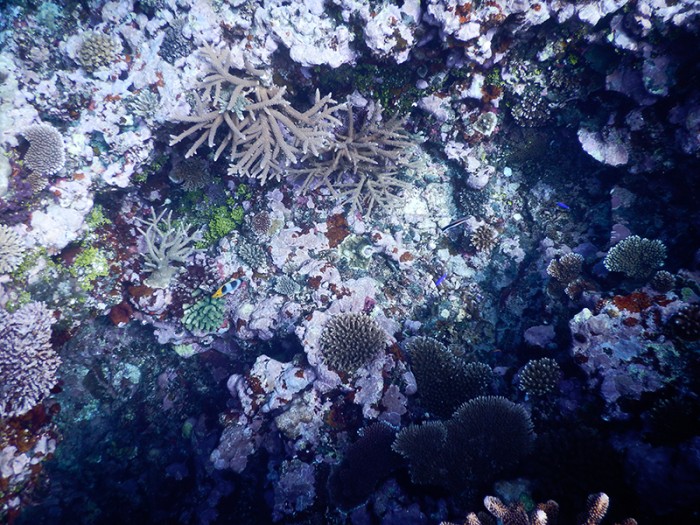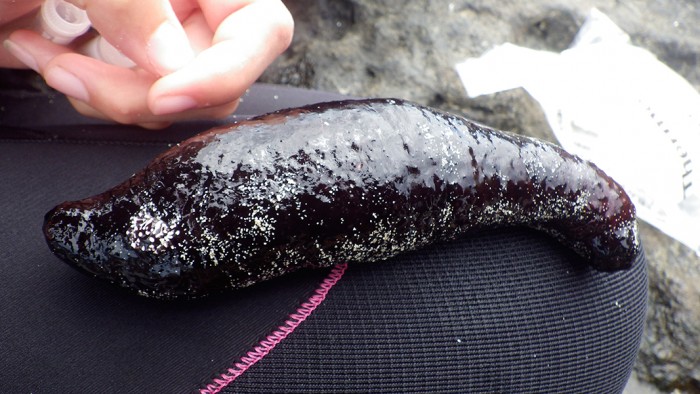If you know of a Columbia College student, faculty member, alumnus/alumna or program we should spotlight, or if you would like to submit a story, please contact:
Columbia College
Office of Communications
cc-comms@columbia.edu

“I left with a better sense of the entanglement between the conservation of marine resources and socioeconomics, politics and globalization.” — Elora López CC’15
This summer, Elora López CC’15 received the Class of 1939 Summer Research Fellowship, the Earth Institute Student Travel Grant and the Columbia University Scholars Program [CUSP] Summer Enhancement Fellowship, allowing her to travel to Fiji to begin research for her thesis, a genetic connectivity project initially meant to focus on the bandedtail goatfish. Below, López reflects on her experience abroad, her research and her newfound understanding of the relationship between marine resources and socioeconomics, politics and globalization.
In the months preceding my departure for my senior thesis research trip to Fiji, I had a hard time convincing family and friends that “research” was not code for lounging in a bikini and sipping mai tais. I certainly knew that was not my plan, but I couldn’t help but feel like I had pulled off some sort of fiendish stunt. Through a combination of contacting the right professor and applying for every grant that seemed remotely applicable to my research, I had managed to turn my thesis project into a fully funded seven-week trip around the Fijian islands, thanks to support from the Columbia College Class of 1939 Summer Research Fellowship, the Columbia University Earth Institute Student Travel Grant and the Columbia University Scholars Program Summer Enhancement Fellowship. I had completed all of the background research and preparation. Now, I thought, the planning was over and all I had to do was exactly what I had written in my research proposals.
On June 21, I set off to Fiji with my labmates: Joshua Drew, lecturer and M.A. program administrator in Ecology, Evolution and Environmental Biology; Erin Eastwood GSAS’15; and Molly McCargar GSAS’15. I was ready to collect samples of bandedtail goatfish — deo in Fijian — from five different Fijian islands. The goatfish is a food-targeted fish in Fiji, which means that it is caught by commercial and subsistence fishers and eaten by Fijians. I planned to spear the fish myself, while scuba diving and snorkeling, and to also buy already-caught goatfish samples from fishers who lived in the five villages we visited. I would then bring these fish back to New York, sequence DNA from their gill tissue, and analyze the degree to which fish on different reefs were related to or isolated from one another. From this genetic connectivity data I would be able to infer patterns of the bandedtail goatfish’s migration and dispersal, information that is crucial for Fijian conservation managers, who strive to incorporate scientific data into their designs for marine protected areas. I had little sense of what to expect from Fiji or field research, but I was excited to begin.
 A small sample of the coral diversity on Nagigi Village’s outer reef. Photo: Elora López CC’15
A small sample of the coral diversity on Nagigi Village’s outer reef. Photo: Elora López CC’15
As it turned out, we were only able to obtain nine goatfish during the entire trip, and all were from Nagigi, the first village of the five we visited. The village’s pastor was a prolific fisherman who was excited when we showed him pictures of the fish that we were looking for, and even more excited when we paid him market price for the fish he caught. He was the only person throughout the duration of our trip who managed to find any bandedtail goatfish. I never saw even one in the water. The reasons for this were unclear. In Nagigi we were told that the bandedtail goatfish are most abundant in November and December, and in other villages locals did not seem to know why there were so few. Regardless, it was clear that I would need to sample from other species if I was going to have a viable genetic connectivity project.
This wasn’t too difficult, as Fiji’s reefs abound with plenty of other food targets, and I ended up collecting sufficient sample sizes of two different species of fish from each island we visited, as well as a sea cucumber species. Sea cucumber harvesting is one of the most dangerous industries in Fiji. The country’s resources have experienced a huge increase in pressure from foreign markets in the last decade, and demand for sea cucumbers is one of the most intense stresses on Fijian marine resources and human life. Sea cucumbers are used in soups and are considered an aphrodisiac in some East Asian cultures. The resultant high demand drives high prices.
In Malevu Village, I stayed with a Fijian colleague’s uncle, Apete Tamani, and his generous parents, brother, sister-in-law, nieces, and nephews. One afternoon, after a long day of snorkeling on the reef, Apete took me to visit his uncle’s sea cucumber drying racks. Apete was impressed with his uncle’s harvest and the amount of money he stood to make off it: 50 Fijian dollars (about 27 US dollars) per kilogram. There were at least 30 kilograms of sea cucumbers sitting in the dry heat and fierce winds, so all told the racks were probably worth about 810 US dollars — a stunning amount of money considering that, according to the Fiji Islands Bureau of Statistics’ “Poverty and Household Incomes in Fiji in 2008-2009” report, an average household’s monthly income in rural Fiji in 2008 was estimated to be 515 US dollars.
But the human cost of collecting sea cucumbers is A sea cucumber (Holothuria atra) collected on Malevu Village’s reef on the island of Naviti. López and her labmates took small, shallow clips of skin and stored them in cryo tubes, which were kept frozen in liquid nitrogen. The wound began to heal immediately after making the cut, and the sea cucumber was then placed back into the ocean. Photo: Elora López CC’15
just as stunning as the money that the collectors stand to gain. Although there are still sea cucumbers in shallow reefs, the greatest number live in far deeper waters, which historically humans could not access. Now, however, international companies come to Fiji and supply young men with scuba gear, without providing training or warning of the risks involved. Nearly every Fijian that I spoke to about sea cucumber harvesting knew someone who had gotten decompression sickness, had become paralyzed or had died due to some combination of shoddy equipment, lack of training and employers who encourage workers to dive to excessive depths at unsafe speeds many times per day.
A sea cucumber (Holothuria atra) collected on Malevu Village’s reef on the island of Naviti. López and her labmates took small, shallow clips of skin and stored them in cryo tubes, which were kept frozen in liquid nitrogen. The wound began to heal immediately after making the cut, and the sea cucumber was then placed back into the ocean. Photo: Elora López CC’15
just as stunning as the money that the collectors stand to gain. Although there are still sea cucumbers in shallow reefs, the greatest number live in far deeper waters, which historically humans could not access. Now, however, international companies come to Fiji and supply young men with scuba gear, without providing training or warning of the risks involved. Nearly every Fijian that I spoke to about sea cucumber harvesting knew someone who had gotten decompression sickness, had become paralyzed or had died due to some combination of shoddy equipment, lack of training and employers who encourage workers to dive to excessive depths at unsafe speeds many times per day.
I knew none of this prior to arriving in Fiji, but I left with a better sense of the entanglement between the conservation of marine resources and socioeconomics, politics and globalization. The overharvesting of shallow water sea cucumbers has led to dangerous methods of deepwater collection, which has harmed many Fijian men and their families. The Fijian Locally Managed Marine Areas (FLMMA) network is therefore very interested in obtaining the results of our genetic analysis on the sea cucumber species we collected, in the hopes that they can incorporate our research into their plans to conserve and rebound the animals in shallow reef bottoms.
My time swimming, diving, lugging around bulky supplies across land and sea, living without running water and becoming a feast for Fijian insects has passed, but I am certain that the work I did this summer was a launching pad for my future goals in marine research and conservation. I learned, in real time and from the people directly affected, how to maneuver around research challenges, and how science and conservation influence and are influenced by so many additional factors. As I begin my senior year, and the molecular component of my thesis project, I will continue to explore the multifaceted nature of marine conservation. My time in Fiji affirmed my resolve to pursue a graduate degree and career in marine research, and I now move forward more aware of the complex systems that entails.
Elora López CC’15, from San Diego, Calif., is majoring in environmental biology and is the vice president of the Columbia University Environmental Biology Society (CUEBS).
Do you have a story you’d like to submit? Email columbiacollege@columbia.edu.